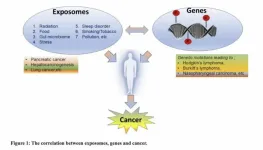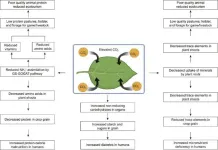(Press-News.org) A research team led by the Department of Energy’s Lawrence Berkeley National Laboratory (Berkeley Lab) has discovered “berkelocene,” the first organometallic molecule to be characterized containing the heavy element berkelium.
Organometallic molecules, which consist of a metal ion surrounded by a carbon-based framework, are relatively common for early actinide elements like uranium (atomic number 92), but they are scarcely known for later actinides like berkelium (atomic number 97).
“This is the first time that evidence for the formation of a chemical bond between berkelium and carbon has been obtained. The discovery provides new understanding of how berkelium and other actinides behave relative to their peers in the periodic table,” said Stefan Minasian, a scientist in Berkeley Lab’s Chemical Sciences Division and one of four co-corresponding authors of a new study published in the journal Science.
A heavy metal molecule with Berkeley roots
Berkelium is one of 15 actinides in the periodic table’s f-block. One row above the actinides are the lanthanides.
The pioneering nuclear chemist Glenn Seaborg discovered berkelium at Berkeley Lab in 1949. It would become just one of many achievements that led to his winning the 1951 Nobel Prize in Chemistry with fellow Berkeley Lab scientist Edwin McMillan for their discoveries in the chemistry of the transuranium elements.
For many years, the Heavy Element Chemistry group in Berkeley Lab’s Chemical Sciences Division has been dedicated to preparing organometallic compounds of the actinides, because these molecules typically have high symmetries and form multiple covalent bonds with carbon, making them useful for observing the unique electronic structures of the actinides.
“When scientists study higher symmetry structures, it helps them understand the underlying logic that nature is using to organize matter at the atomic level,” Minasian said.
But berkelium is not easy to study because it is highly radioactive. And only very minute amounts of this synthetic heavy element are produced globally every year. Adding to the difficulty, organometallic molecules are extremely air-sensitive and can be pyrophoric.
“Only a few facilities around the world can protect both the compound and the worker while managing the combined hazards of a highly radioactive material that reacts vigorously with the oxygen and moisture in air,” said Polly Arnold, a co-corresponding author on the paper who is a UC Berkeley professor of chemistry and director of Berkeley Lab’s Chemical Sciences Division.
Breaking down the berkelium barrier
So Minasian, Arnold, and co-corresponding author Rebecca Abergel, a UC Berkeley associate professor of nuclear engineering and of chemistry who leads the Heavy Element Chemistry Group at Berkeley Lab, assembled a team to overcome these obstacles.
At Berkeley Lab’s Heavy Element Research Laboratory, the team custom-designed new gloveboxes enabling air-free syntheses with highly radioactive isotopes. Then, with just 0.3 milligram of berkelium-249, the researchers conducted single-crystal X-ray diffraction experiments. The isotope that was acquired by the team was initially distributed from the National Isotope Development Center, which is managed by the DOE Isotope Program at Oak Ridge National Laboratory.
The results showed a symmetrical structure with the berkelium atom sandwiched between two 8-membered carbon rings. The researchers named the molecule “berkelocene,” because its structure is analogous to a uranium organometallic complex called “uranocene.” (UC Berkeley chemists Andrew Streitwieser and Kenneth Raymond discovered uranocene in the late 1960s.)
In an unexpected finding, electronic structure calculations performed by co-corresponding author Jochen Autschbach at the University of Buffalo revealed that the berkelium atom at the center of the berkelocene structure has a tetravalent oxidation state (positive charge of +4), which is stabilized by the berkelium–carbon bonds.
“Traditional understanding of the periodic table suggests that berkelium would behave like the lanthanide terbium,” said Minasian.
“But the berkelium ion is much happier in the +4 oxidation state than the other f-block ions we expected it to be most like,” Arnold said.
The researchers say that more accurate models showing how actinide behavior changes across the periodic table are needed to solve problems related to long-term nuclear waste storage and remediation.
“This clearer portrait of later actinides like berkelium provides a new lens into the behavior of these fascinating elements,” Abergel said.
This work was supported by the DOE Office of Science.
###
Lawrence Berkeley National Laboratory (Berkeley Lab) is committed to groundbreaking research focused on discovery science and solutions for abundant and reliable energy supplies. The lab’s expertise spans materials, chemistry, physics, biology, earth and environmental science, mathematics, and computing. Researchers from around the world rely on the lab’s world-class scientific facilities for their own pioneering research. Founded in 1931 on the belief that the biggest problems are best addressed by teams, Berkeley Lab and its scientists have been recognized with 16 Nobel Prizes. Berkeley Lab is a multiprogram national laboratory managed by the University of California for the U.S. Department of Energy’s Office of Science.
DOE’s Office of Science is the single largest supporter of basic research in the physical sciences in the United States, and is working to address some of the most pressing challenges of our time. For more information, please visit energy.gov/science.
END
Gastrointestinal (GI) bleeding is a common and potentially life-threatening condition that requires prompt and accurate diagnosis. Esophagogastroduodenoscopy (EGD) and colonoscopy are the primary diagnostic modalities, but initial examinations may sometimes fail to identify the bleeding source. In such cases, repeated endoscopic evaluations can improve detection rates. This review explores the role of repeat EGD and colonoscopy in diagnosing GI bleeding, highlighting the conditions under which they are most beneficial and the challenges associated with their use.
Incidence and Causes of Gastrointestinal ...
PHILADELPHIA – Since 2017, firearm-related injuries in the United States have been the most common cause of death from injury among children through young adults, ages 1 to 24, surpassing motor vehicle accidents, according to a 2022 study. Access to firearms in one’s home increases the risk of suicide and accidental death.
But over a third of Americans with guns in their homes say they do not store all of them in a locked location (37%), according to the latest health survey from the Annenberg Public Policy Center (APPC) of the University of Pennsylvania. ...
“Environmental exposures may cause genetic damage, lead to mutations in key genes, and/or block the DNA repair mechanisms increasing the risk of cancer.”
BUFFALO, NY – March 11, 2025 – A new editorial was published in Oncotarget, Volume 16, on March 10, 2025, titled “EXPOSOMES and GENES: The duo influencing CANCER initiation and progression.”
In this editorial, Drs. Uzma Saqib, Katherine E. Ricks, Alexander G. Obukhov, and Krishnan Hajela from Devi Ahilya Vishwavidyalaya (DAVV) in Indore, India, discuss how environmental factors, known as exposomes, interact with genes to influence cancer risk. The authors highlight how pollution, diet, ...
A recent study published in Engineering delves into the complex impacts of elevated CO2 levels on food security, plant growth, and crop quality. As the global atmospheric CO2 concentration continues to rise, understanding these effects is crucial for ensuring future food supplies.
On one hand, elevated CO2 can have some positive effects on plants. For C3 plants, it can stimulate photosynthesis, leading to increased dry matter yield and grain production. In legumes, it enhances N2 fixation, which is beneficial for reducing reliance on chemical fertilizers. Additionally, ...
Researchers from RMIT University and the University of Melbourne have discovered that water generates an electrical charge up to 10 times greater than previously understood when it moves across a surface.
The team, led by Dr Joe Berry, Dr Peter Sherrell and Professor Amanda Ellis, observed when a water droplet became stuck on a tiny bump or rough spot, the force built up until it “jumped or slipped” past an obstacle, creating an irreversible charge that had not been reported before.
The new understanding of this “stick-slip” motion of water over a surface paves the way for surface design with controlled electrification, with ...
Miami (March 11, 2025) – People with chronic obstructive pulmonary disease (COPD) and arthritis have a higher risk of death than people with arthritis who do not have COPD, according to a new study. The study is published in the January 2025 issue of Chronic Obstructive Pulmonary Diseases: Journal of the COPD Foundation, a peer-reviewed, open-access journal.
COPD is an inflammatory lung disease, comprising several conditions, including chronic bronchitis and emphysema, and can be caused by genetics and irritants like smoke or pollution. The disease affects more than 30 million Americans and is the fourth leading cause of death ...
WASHINGTON, DC – The Editorial Board of the Proceedings of the National Academy of Sciences (PNAS) has selected six papers published by PNAS in 2024 to receive the Cozzarelli Prize, an award that recognizes outstanding contributions to the scientific disciplines represented by the National Academy of Sciences (NAS). Papers were chosen from more than 3,200 research articles that appeared in the journal last year and represent the six broadly defined classes under which the NAS is organized. Additionally, the Editorial Board has recognized six papers—one ...
The American Meteorological Society continuously publishes research on climate, weather, and water in its 12 journals. Many of these articles are available for early online access–they are peer-reviewed, but not yet in their final published form. Below are some recent examples.
JOURNAL ARTICLES
Climate Change Increases Energy Demand and Cost in Texas
Weather, Climate, and Society
Climate change is driving large increases in electricity demand and costs in Texas’ ERCOT market. Compared to a 1950–1980 baseline climate, ERCOT electricity demand in 2023 was 1.9 ...
Written by Jessica Colarossi
Microplastics—tiny shards of plastic debris—are all over the planet. They have made their way up food chains, accumulated in oceans, clustered in clouds and on mountains, and been found inside our bodies at alarming rates. Scientists have been racing to uncover the unforeseen impacts of so much plastic in and around us.
One possible, and surprising, consequence: more drug-resistant bacteria.
In a startling discovery, a team of Boston University researchers found that bacteria exposed to microplastics became resistant to multiple types of antibiotics commonly used to treat infections. They ...
Washington, D.C.—Microplastics are not just pollutants, but also highly complex materials that facilitate antimicrobial resistance, even without antibiotics, according to a new study. The findings were published in Applied and Environmental Microbiology, a journal of the American Society for Microbiology.
“Addressing plastic pollution isn’t just an environmental issue—it’s a critical public health priority in the fight against drug-resistant infections,” said lead study author Neila Gross, a Ph.D. candidate in the lab of Professor Muhammad ...




